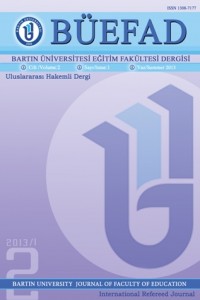Abstract
Görsel okuma, dinleme, konuşma, okuma, yazma gibi dilin öğrenme alanlarından biridir. Çoğu ülkenin dil öğretim programlarında ayrı bir alan olarak ele alınmakta ve öğrencilere kazandırılacak beceriler sıralanmaktadır. Eğitim sürecinde ise çeşitli yaklaşımlar uygulanmaktadır. Dünyamızda uygulanan yaklaşımlar genel olarak “davranışçı, bilişsel ve yapılandırıcı” olmak üzere üç ana grupta toplanmaktadır. Eski yaklaşımlar görsel okuma eğitiminde görselleri tanıma ve anlamlandırma çalışmalarına önem veriyordu. Günümüz yaklaşımları ise görsellerin algısal, zihinsel ve duygusal etkilerine odaklanmakta, öğrencilerin çeşitli becerilerini geliştirmek için görsel okumadan yararlanmaktadır. Görsel okuma eğitiminde öğrencilere önce bakış eğitimi verilmekte, ardından görsel kodları keşfetme, tanıma, anlama, görseller hakkında hissedilenleri paylaşma, hayal gücünü zenginleştirme ve yaratıcılık becerilerini geliştirme çalışmaları yapılmaktadır. Görsel okuma etkinlikleriyle öğrencilerin kendilerini yazılı ve sözlü ifade etme, anlama ve sorgulama becerilerini geliştirmeleri, kültür ve çevrelerine ilişkin bilgileri öğrenmeleri amaçlanmaktadır. Bu konuda ülkemizde de önemli gelişmeler olmuş, görsel okuma eğitimi 2005 Türkçe 1-5.Sınıflar Öğretim Programında ilk kez ayrı bir alan olarak ele alınmış, öğrencilere kazandırılacak beceriler sıralanmıştır. Görsel okuma eğitiminde ise yapılandırıcı yaklaşım benimsenmiş, öğrencilerin görsel okuma becerilerini geliştirmek için Programda çeşitli kazanım, etkinlik, görev ve projeler önerilmiştir. Böylece ülkemizde de görsel okuma becerileri ile öğrencilerin dil, zihinsel, duygusal ve sosyal becerileri geliştirilmeye çalışılmaktadır.
Keywords
References
- Battut, E and Bensimhon, D. (2001). Lire et comprendre les images à l’école, édition RETZ.
- Chion, M. (1990). L’audiovision, Université de Nathan.
- Depaire, I. (2007). Conseillère pédagogique en Arts Visuels, IA 33
- Güneş, F. (1997).Okuma Yazma Öğretimi ve Beyin Teknolojisi. Ankara: Ocak Yayınları
- Güneş, F. (2007).Türkçe Öğretimi ve Zihinsel Yapılandırma, Ankara: Nobel Yayınları
- Güneş, F. (2009). Hızlı Okuma ve Anlamı Yapılandırma, Ankara:Nobel Yayınları
- Hamm, L. (1986). Lire Des İmages, Armand Colin-Bourrelier.
- Joly, M. (2004). Les trois dimensions de l’image. Sciences Humaines. Hors série n°43, janvier- février 2004, p.10-13
- La Borderie, R. (1997). Education à l'image et aux médias. Nathan pédagogie.
- Lieury, A. (1995).Memoire des images et double codage,l’annee psychologique,No:95
- Lieury, A. (1996).Memoire ou memoires? Universite Rennes, France.
- Lima, L. (2003). La Compréhension de l’ecrit, Laboratoire de Sciences de l’Education,UPMF
- Loesel , B. (1990). Photos Dards...Aiguillons Pédagogiques...,CDDP de Seine-Maritime
- MEB. Talim ve Terbiye Kurulu Başkanlığı (2005). İlköğretim Türkçe Dersi Öğretim Programı ve Kılavuzu,Ankara: MEB Basımevi.
- OECD (2003). Cadre d.évaluation de PISA 2003
- Palandri, C. (1995).la lecture d’images: une aide pour l’enfant en difficultés?, IUFM de Strasbourg
- Passegand ,J.C. ( 1989). Images cinématographiques et apprentissages,CRDP de Dijon.
- Tardif, J. (1999). Le transfert des apprentissages. Montréal, Éditions Logiques.
- Tardif, J.(1997). Pour un enseignement stratégique. Montréal : Editions Logiques.
Abstract
Visual reading is one of the language learning domains as listening, speaking, reading and
writing. It is addressed as a separate domain in many countries’ language education programs and the
skills to be cultivated in students are listed. In the period of education, on the other hand, there are
various approached used. The approaches used around the world can be broadly grouped under three
main topics, which are “behavioral, cognitive and constructivist approaches”. Old approaches put
emphasis on recognizing and interpreting visuals in visual reading education. Today’s approaches,
however, focuses on the receptive, cognitive and affective impacts of the visuals and utilize visual
reading to develop multiple skills of students. In teaching visual reading, students are first trained for
perspective, and then for discovering visual codes, recognizing, understanding, sharing what is felt about
the visuals, enriching imagination and developing creativity skills. The aim of visual reading is to develop
students’ skills of expressing themselves both written and orally as well as their understanding and
questioning skills and to help them learn about culture and their environment. There have also been
significant developments in this field in our country and for the first time, visual reading was classified as
a separate domain in 1-5
th graders Turkish Teaching Program in 2005 and the skills to be cultivated in
students were listed. Constructivist approach is adopted in visual reading education; and multiple
acquisitions, activities, assignments and projects are suggested in the program in order to develop visual
reading. Thereby, the aim is to develop the language, cognitive, affective and social skills of the students
in our country through visual reading skills.
References
- Battut, E and Bensimhon, D. (2001). Lire et comprendre les images à l’école, édition RETZ.
- Chion, M. (1990). L’audiovision, Université de Nathan.
- Depaire, I. (2007). Conseillère pédagogique en Arts Visuels, IA 33
- Güneş, F. (1997).Okuma Yazma Öğretimi ve Beyin Teknolojisi. Ankara: Ocak Yayınları
- Güneş, F. (2007).Türkçe Öğretimi ve Zihinsel Yapılandırma, Ankara: Nobel Yayınları
- Güneş, F. (2009). Hızlı Okuma ve Anlamı Yapılandırma, Ankara:Nobel Yayınları
- Hamm, L. (1986). Lire Des İmages, Armand Colin-Bourrelier.
- Joly, M. (2004). Les trois dimensions de l’image. Sciences Humaines. Hors série n°43, janvier- février 2004, p.10-13
- La Borderie, R. (1997). Education à l'image et aux médias. Nathan pédagogie.
- Lieury, A. (1995).Memoire des images et double codage,l’annee psychologique,No:95
- Lieury, A. (1996).Memoire ou memoires? Universite Rennes, France.
- Lima, L. (2003). La Compréhension de l’ecrit, Laboratoire de Sciences de l’Education,UPMF
- Loesel , B. (1990). Photos Dards...Aiguillons Pédagogiques...,CDDP de Seine-Maritime
- MEB. Talim ve Terbiye Kurulu Başkanlığı (2005). İlköğretim Türkçe Dersi Öğretim Programı ve Kılavuzu,Ankara: MEB Basımevi.
- OECD (2003). Cadre d.évaluation de PISA 2003
- Palandri, C. (1995).la lecture d’images: une aide pour l’enfant en difficultés?, IUFM de Strasbourg
- Passegand ,J.C. ( 1989). Images cinématographiques et apprentissages,CRDP de Dijon.
- Tardif, J. (1999). Le transfert des apprentissages. Montréal, Éditions Logiques.
- Tardif, J.(1997). Pour un enseignement stratégique. Montréal : Editions Logiques.
Details
| Primary Language | Turkish |
|---|---|
| Subjects | Studies on Education |
| Journal Section | Articles |
| Authors | |
| Publication Date | June 10, 2013 |
| Published in Issue | Year 2013 Volume: 2 Issue: 1 |
All the articles published in the journal are open access and distributed under the conditions of CommonsAttribution-NonCommercial 4.0 International License

Bartın University Journal of Faculty of Education


